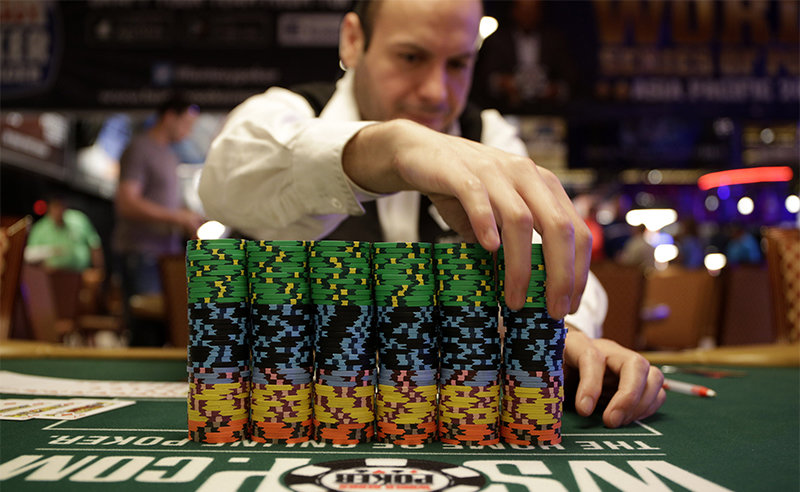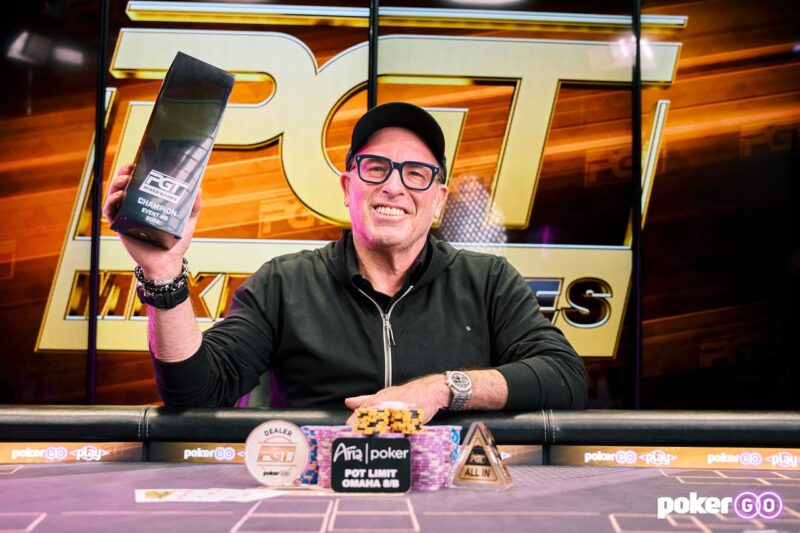Those who regularly play in the World Series of Poker in Las Vegas have probably noticed that the “quality” of the series has improved significantly over the years. The 2019 series promises be even better.

Poker Strategy for the Rest of Us …
by Steve Selbrede
In Chapter 3 of my book Tournament Poker for the Rest of Us, I discuss tournament quality metrics as a means of analyzing a prospective tournament experience for players of skill. When looking at how these parameters apply to the WSOP tournament structures, we can see why skilled players maintain a strong advantage when fighting for bracelets.
The most useful metrics are Blind-Off Time (BOT) and Medium Utility Hands (HM), either of which can be used to compare the “quality” of different tournaments. For the purpose of this discussion, “quality” is equivalent to tournament speed. The slower a tournament structure is, the more hands we will be dealt, which provides time for our superior poker skill to forge an advantage.
Introduction to Blind-Off Time
The simplest and most intuitive quality metric is the true Blind-Off Time (BOT). This is simply the number of hands we would be dealt before being blinded off, assuming we never play a hand. This is the true BOT because we take into account the fact that the blinds and antes increase over time.
We could express BOT in hours, but different tournaments can have different hand dealing rates. (Online dealing rates are higher than live rates, and auto-shufflers are faster than manual shuffling.) To avoid awkward correction factors, I express BOT as the number of hands-dealt so that tournament comparisons are easier to make. After all, what matters is the number of hands we expect to play, not the number of hours.
Since we are presumably players with a high degree of skill, we will generally prefer tournaments with the highest BOT for the money.
Hmmm ?… Understanding HM
Although BOT is a useful metric, we don’t really care how many hands we see before being blinded off since no one actually plays a tournament that way. It may be more practical to know how many hands we can play with at least medium chip utility (HM), which I define as a stack of at least 30 big blinds (with antes).
I use our original starting stack as a reference point in this calculation since a skilled player with average luck should be able to maintain his original stack.
So HM is the number of hands we can play before our stack drops below 30 BBs, assuming we still have our starting chips. Although this standard is somewhat arbitrary, it is much closer to the way a player actually plays.
A skilled player should prefer a slower tournament structure with a higher HM. Therefore, for us, HM is equivalent to quality. Nevertheless, BOT is easier to calculate and closely tracks HM. In practice, both metrics work just fine.
Evaluating Structure Sheets
Calculating BOT and HM require knowledge of the blind/ante structure for our tournament. This includes the sizes of the SB, BB and ante for each level. An example of this can be found in the first four columns of Figure 1, which was the structure for the 2018 WSOP Main Event. We calculate the orbit cost by simply adding SB + BB+ Antes. This is even easier for tournaments with Big Blind Ante (BBA) structures.

Creating this chart is easy with a spreadsheet, but it can also be done with pen and paper. Since most of us play in a small number of local tournaments, we won’t need to do this often. Once we have the tournament structure, we calculate the number of hands dealt during each level. In the case of the Main Event, I used 30 hands dealt per hour with 2 hour levels, which is 60 hands per level. Then we subtract the level cost from our previous stack to find our remaining stack, listed in the “Stack” column.
For example, we have 48,650 chips at the end of level 1 and 1,550 chips at the end of level 7. Since we see 420 hands during these first 7 levels, our BOT is a slightly higher 428 hands (extrapolated).
Suppose we are able to maintain our original starting stack during the first 10 levels. The “SS” column shows how many big blinds this would be at the beginning of the next level.
For example, 50,000 chips would be 167 BBs at the beginning of level 2, (50,000 divided by 300). We can estimate HM by finding the first level where our stack drops below 30 big blinds. For the Main Event, we would have 31 BBs at the start of level 10, so we could play until the end of level 10 (600 hands) with at least 30 BBs with our original 50,000 chips.
Calculating BOT and HM are fairly straightforward once we create a chart like Figure 1. I show in my book that these two metrics track each other fairly well, so we can use which ever metric we prefer to compare tournament quality.
WSOP Gets Quantifiably Better
Figure 2 summarizes tournament quality parameters for a few WSOP tournaments. Nearly all 2019 WSOP tournaments have better quality parameters than their 2018 equivalent.

The first major change is that all of these 2019 tournaments have switched to Big Blind Ante (BBA) structures. Although logic would suggest that the dealing rate would increase with the BBA, the data suggests that the actual dealing rate is unchanged from traditional ante structure.
The second major change is that the starting stacks have been significantly increased. This is partly due to a desire to eliminate the smallest denomination chips. But it also seems that the WSOP has decided to increase the amount of play by improving the blinds structure itself.
Consider the Main Event. The 2019 tourney uses the BBA and increased the starting stack to 60,000 chips. This improved its BOT by about 12%.
Or consider the 2019 Seniors event, which has the same structure as the Super Seniors and Women’s events. Switching to the BBA and providing a 4-fold larger starting stack has increased the BOT by 46% and HM by 75%! This is without increasing the entry fee. The 2019 Millionaire Maker tournament has improved BOT by 91% and HM by a whopping 140%.
The Colossus is an even better example. Not only have they increased the starting stack by a factor of eight, they also increased the level time from 30 minutes to 40 minutes and decreased the entry fee. HM has improved by a factor of 3.3! Just a few years ago the Colossus was a crap shoot. Now it is a high quality tournament.
Yet not every tournament has improved. For example, the 2019 $1,000 Double Stack tournament has increased the starting stack but decreased the level time, resulting in a structure that is similar to its 2018 version.
Conclusion
The 2019 WSOP promises to be a very exciting series. Most of the traditional contests have improved their structures drastically, often doubling the amount of play we can expect. This is a big deal for a skilled player since it gives us more time to overcome bad luck.
Steve Selbrede is the author of six books: The Statistics of Poker, Beat the Donks, Donkey Poker Volume 1: Preflop, Donkey Poker Volume 2: Postflop, Donkey Poker Volume 3: Hand Reading and Tournament Poker for the Rest of Us.


